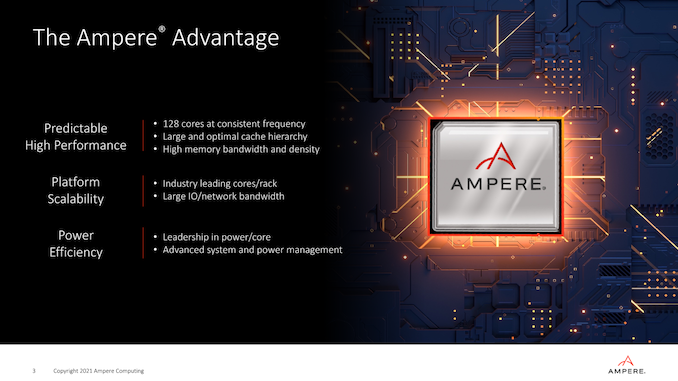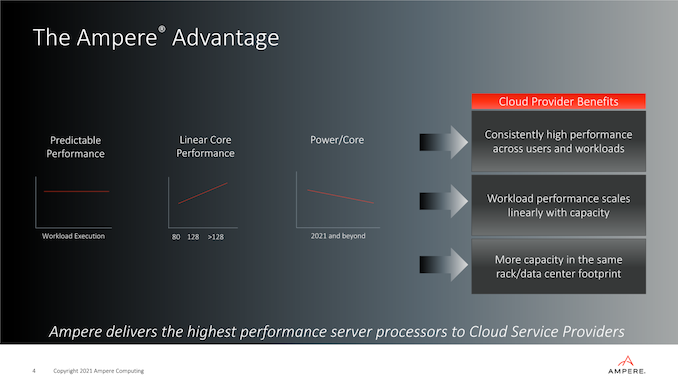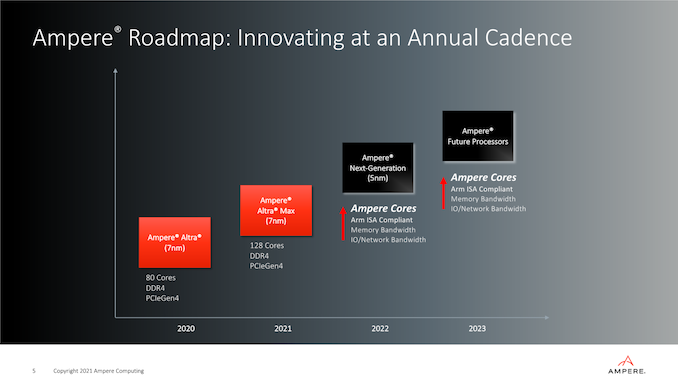
Ampere was founded in 2017 by former Intel president Renée James with a group of former Intel engineers willing to take risks with James. Initially, the company relied on the IP and design talent of the former AppliedMicro's X-Gene CPU, still supporting legacy products such as the eMAG series. The company is also a supplier to major Chinese Internet companies such as Tencent Cloud and ByteDance.
As Arm began to focus more on designing and releasing data center and enterprise CPU IP lineups in the form of new Neoverse core products a few years ago, we've finally seen the fruits of these efforts over the past two years or so, with several third A generation of Neoverse N1 server CPU product releases, such as Amazon's Graviton2, and more importantly, Ampere's "Altra Quicksilver" 80-core server CPU.
The Altra Q series is undoubtedly one of the most impressive Arm server CPUs of the past few years, with chips capable of matching or beating AMD and Intel's high-end offerings, and even extending that positioning to the latest generation of Xeons and EPYCs.

Ampere's next-generation "Mystique" Altra Max is the next product on the roadmap, targeting a late '21 release. The design relies on the same first-gen Arm Neoverse N1 cores while having a maximum 250W TDP as a drop-in replacement on the same platform, but has been optimized to now allow up to 128 CPU cores, a 60% increase over the first iteration , twice as many cores as competing AMD or Amazon Graviton2 systems.

For future designs beyond the Altra Max, Ampere promises that they will continue to emphasize what they believe to be "predictable performance" for socket-loaded scalable workloads, increasing core counts with linearly increasing performance, while I found that also found An interesting metric that continues to reduce power per core:
Replacing Neoverse with a fully custom kernel
The microarchitecture choices Ampere will use in its next-generation 2022 "Siryn" design, which is an upgraded version of the Altra Max, are related to the CPU IP being used:

Starting with Siryn, Ampere will switch from Arm's Neoverse cores to their new in-house fully custom CPU microarchitecture. Admittedly, this news caught us off guard, as we had expected Ampere to continue using Arm's Neoverse cores for the foreseeable future. The move to an all-new fully custom microarchitecture has put Ampere down a completely different path than we originally expected.
In fact, Ampere explained that the company has been planning a fully custom microarchitecture core design from the start, and their custom CPU design has been in the works for the past 3+ years.
The design team for this work was led by Ampere's CTO Atiq Bajwa, who is also the project's lead architect. Bajwa and his team appear to be largely made up of high-profile former Intel engineers and veterans who left Intel in 2017 with Renée James, and they have been joined by talent from many other companies in the industry. The team's history and pedigree are known for their work on Intel's Haswell and Broadwell processors.
Ampere's explanation and rationale for designing a fully custom core is that they claim they are able to achieve better performance and greater power efficiency in workloads in the data center than Arm's Neoverse "more general purpose" design . That's a very interesting statement, contrasting Arm's predictions and goals for the core of the Neoverse. The recent Neoverse V1 and N2 cores were released in more detail last year and claimed to achieve significant cross-generation IPC gains.
Ampere dropped their reliance on Arm's next-gen cores in favor of their own designs, and actually implementing this shift in their next-gen products shows that they have confidence in their custom microarchitecture design, while one can interpret it as Signs of distrust of Arm's Neoverse IP and roadmap. This contrasts with what the rest of the industry is doing: Marvell has discontinued its own ThunderX CPU IP development in favor of Arm Neoverse cores. On the other hand, not specifically related to the cloud server market, Qualcomm bought Nuvia early last year, and their rationale and explanation were similar to Ampere's, as they claimed the new internal design could deliver performance that Arm's Cortex CPU IP couldn't.
Ampere Chief Product Officer Jeff Wittich explained that this announcement will hopefully help us better paint a picture of where Ampere is going as a company - whether they will continue to be content with being "merely" an Arm IP integrator, or if they have more plans . Jeff is clear that in a few years, their vision is for Ampere to be a top CPU vendor in the cloud market and a major player in the industry.
As far as technical details go, how Ampere's CPU microarchitecture will be different in terms of approach, and how and why they see it as a great performer in the cloud, are questions we'll have to be more patient with. The company hasn't commented on the exact status of the Sirin design -- whether it's being tapped or taped -- but they did reiterate that they plan to conduct customer sampling in early 2022 based on their previous roadmap. From the tone of the discussion, the design appears to be largely complete and Ampere is putting the finishing touches on the entire SoC. Jeff mentioned that in due course, they will also have a microarchitectural disclosure of the new core, explaining their design choices in terms of front-end or back-end design, etc., and why they think it's a better fit for the cloud market.
In addition to long-term plans beyond 2022, the roadmap update also includes some performance claims for Ampere's upcoming 128-core Altra Max product, which will be available in 2H21.

Codenamed "Mystique," the Altra Max design features the ability to increase the core count by 60 percent compared to the current-generation Altra design, while maintaining the same 250W TDP or less. The graph above shows a performance comparison with previous generation competitors, and Ampere simply explained that they couldn't get the latest Milan or Ice Lake-SP hardware to test. Still, the relative positioning to the Altra Q80-30 and EPYC 7742 suggests that the new chip can easily outperform even AMD's latest EPYC 7763.
In the image above, Ampere has disclosed the SKU model name for comparison, which is "Altra Max M128-30", which means for the first time we've confirmed that all 128 cores are clocked at up to 3GHz, and we can see it and the Q80- The same TDP and power characteristics between 33.